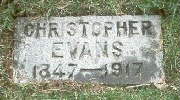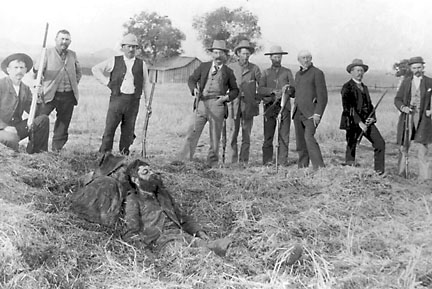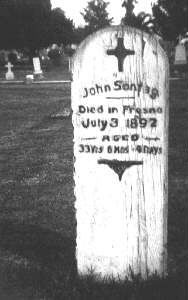Sontag and Evans
John Sontag and Chris Evans were train robbers in the late 1800's. They lived and hid in the foothills near Eshom Valley. Following is a short account of their lives.
Christopher Evans was born in Ottawa, Canada in 1847. He left home at an early age and was found in Tulare County in 1874 when he married Molly Byrd whose family owned a ranch 25 miles northeast of Visalia.
Although their first born had died in infancy, a daughter, Eva, grew to be very close to her father. A son, Elmer, also died at an early age, but two additional daughters, Ynez and Winifred added to the joy of the young couple.
Evans had operated a steamboat on Owens Lake, worked in a mine in San Luis Obispo County and pilot gang-plows and run harvesters. About 1887, he met an unemployed railroad brakeman named John Sontag.
Born John Contant on May 27, 1860. At a young age, John Sontag's father died and his mother remarried a man named Sontag and John took his stepfather's name. John's younger brother, George kept the original family surname.
John moved from Minnesota to California and went to work for the Southern Pacific Railroad. In 1887, he was seriously injured while working in Fresno coupling train cars. He claimed the SP dismissed him while he was still injured and he became very bitter toward the railroad. At this time, the Southern Pacific was despised by the people of the San Joaquin Valley because of excessive freight rates and the bloody Mussel Slough incident.
When Evans met Sontag, he invited him to help work his farm. They mortgaged Evan's property to lease a livery stable in Modesto. A year later, a fire burned the stable and killed his horses, and Evans was back to his Tulare farm. What happened to Chris Evans Property?
Train robberies soon began. Pixley, Goshen, Ceres, Collis (Kerman), and Atila (Earlimart) were chosen sites and Sontag and Evans were given the credit. Johns brother, George Contant was convicted of the Collis robbery and he went to Folsom state prison. Evans and Sontag would always deny they had robbed the trains, but had to remain in hiding in the foothills near Eshom Valley. They were known to hide out in Sampson's Flat and at Camp Manzanita and Fort Defiance.
While getting supplies at the Evans farm, a lurking posseman shot their horse. Evans and Sontag returned fire and killed Deputy Sheriff Beaver.
Evans later said " We are entirely guiltless of the train robbery" and "we never killed anyone except in self defense". Sontag had become engaged to Evans daughter, Eva.
Lawmen from Tulare and Fresno Counties, Pinkerton Agents, US Marshalls, railroad detectives, bounty hunters and hired Indian Scouts were in constant search for the two wanted men. Finally , at the Young Ranch, there was a shoot-out that left Officer Wilson and bounty hunter McGinnis dead. Sontag was shot in the right arm.
|
|
| Reenactment of the shoot-out at Youngs Cabin at Pine Ridge. Wilson and McGinnis lay before Sontag and Evans near the cabin. -Annie Mitchell collection |
Sontag and Evans had two know hideouts in the Eshom Valley area. Both places were known by trusted locals who brought their mail and supplies. One, known as Fort Defiance, is in Dark Canyon to the north and the second, refered to as Camp Manzanita, is on Red Hill.
On June 11, 1893, a posse lay in ambush at the Bacon cabon for the duo along the trail near Stone Corral. They finally spotted them late in the day as the two rested near a manure pile and opened fire. Several hundred shots were exchanged until dark overtook them. Evans was hit in the right eye, back and in both arms. Sontag had been hit several times, including the forehead and chest. More about Stone Corral
Knowing that Sontag was close to death, Evans made a break for a friends home eight miles away in Auckland. He had lost an eye and would have his left arm amputated.
Not knowing how badly Sontag was injured, the posse waited until morning when more help would arrive. With the arrival of daylight, they cautiously approached Sontag who was hidden in the straw and manure pile. Barely alive, he was easily arrested and placed in a wagon for Visalia.
|
||
John
Sontag, as he is photographed in the manure and straw pile
before being loaded in a wagon for Visalia. The building in
the background is the abandoned "Bacon cabin" on
the patterson ranch where the posse waited for Evans and Sontag. |
|
|
|
Sontag lived
for another three weeks before he died of tetanus in Fresno Buried in Fresno., this original wooden marker appears to indicate 1892 rather than 1893 as all records show. Photo courtesy of Forrest Cooper |
With the help of Ed Morrell, Evans escaped from the Fresno County Jail but was recaptured and sentenced to Folsom State Prison where Johns' brother, George was doing time. While in prison, Evans wrote Eurasia, a theory for a socialist state. He was pardoned in 1911 and was banished from California. He finished his life in Oregon
 |
George Contant made an escaped attempt where three convicts were killed and several others, including Contant, was wounded. He was pardoned fourteen years later. His book, A Pardoned Lifer, came out in 1914 and a movie of Sontag and Evans was made from the book.
Go to the EshomValley Home Page.


